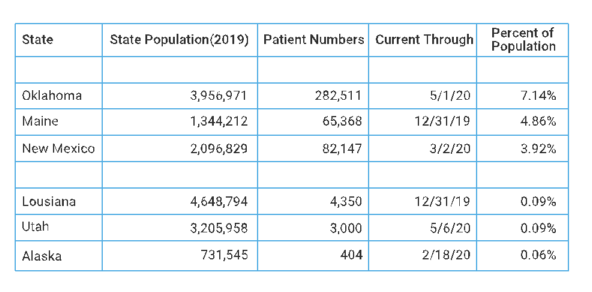by Ryan Douglas, founder of Ryan Douglas Cultivation
In thriving cannabis markets, demand exceeds supply. For successful cultivation businesses, expansion is the logical next step — either through organic growth or the acquisition of operational cultivation assets. Before moving forward with an expansion project, entrepreneurs should carefully determine when is the appropriate time to expand. There are a number of market indicators that can help entrepreneurs decide if expansion is right for them — such as market demand, growth of market, and the potential for adult-use sales.
Current market demand for your product
What is the overall market demand for cannabis, and, more importantly, what is the demand for the cannabis that you cultivate? The answers to this question should be reflected in your sales volume and price point, and it should help influence a company’s decision on whether or not to expand. If you’re wholesaling your product to dispensaries for re-sale, or to large oil extractors of raw cannabis biomass, are you currently selling everything that you grow? Are customers calling you looking for product before it’s even harvested? Or, are you spending hours on the phone trying to unload product before the next harvest? How does your product sell at the dispensary, compared to your competitor? Does it fly off the shelf or frequently find itself discounted as the weekly special?
The price at which you’re selling your dried cannabis flower should be an excellent indication of whether or not expansion makes sense. Do you spend much time haggling over money, or can you name your price? In hot new markets, where there are few suppliers and great demand, wholesale cultivators can charge up to $4,000 per pound for indoor-grown cannabis. In more seasoned markets with multiple cultivators, wholesale prices are closer to $1000 to $1500 per pound. The closer your sales are to $4,000 per pound, the more it makes sense to expand.

Figure 9.2 Wholesale prices across the U.S. as of April 2020. Copyrighted by Marijuana Business Daily, MJBizDaily.com. Used with permission.
Size and growth of market
The size and growth rate of a medical cannabis market is a good indicator of whether or not a business should consider expanding. In regions with a medical cannabis program, the percentage of the adult population registered as medical cannabis patients is an excellent indicator of the current size of the medical market. However, a cannabis business considering an expansion should be less concerned with how big the market is today, and more focused on how large it may be tomorrow instead.
In most U.S. states, about two percent of the adult population become medical cannabis consumers. A rate of lower than one percent is rare. This typically occurs when there are few doctors willing to prescribe cannabis, or there’s a very restrictive list of medical conditions for which cannabis can legally be prescribed. In Oklahoma, more than seven percent of adults are registered cannabis patients, while in Ohio only 0.6% of the adult population have registered as medical patients. If the percentage of adult medical patients in your area is above two percent, it’s a good sign that the medical cannabis industry is thriving. Markets with more patients are more attractive for cultivators to expand.

Figure 9.3 The top three and bottom three U.S. medical cannabis markets by percentage of registered adult patients. Source: Marijuana Policy Project
The rate of new patient registrations is a much better indicator of a given market’s potential for growth. Single-digit increases in new patient registrations year-over-year are not positive indicators. Cultivation businesses considering expansion want to be in states where the number of medical patients is increasing by at least twenty percent annually. This kind of growth would indicate a widespread adoption of medical cannabis and few barriers to receiving a medical cannabis prescription. Florida is an example of a thriving medical cannabis market, where patient registrations increased fifty percent during 2019 alone to over 300,000 patients. This kind of positive growth gives cultivation businesses a good reason to expand.
Competition
However, a robust cannabis market may not make the best expansion opportunity if there are numerous cultivators competing for the same customer base. California and Colorado are established cannabis markets — both medical and [adult-use] — servicing millions of customers each year. That’s exactly the reason expanding in those states may not be as lucrative as opportunities presented by less populated states. In 2019, California sold an estimated $3 billion in recreational cannabis — but there are nearly 3,000 licensed recreational cultivators in the state. In saturated cultivation markets, wholesale flower is quickly relegated to a commodity. Large, established markets, like California and Colorado, don’t hold the same potential value for expansion as a state that may have fewer consumers but is on the cusp of legalization.
Competition doesn’t only come from other licensed commercial cultivators, but from caregivers as well. Caregivers are home growers that are permitted to cultivate plants for medical cannabis patients. Consumers appreciate the personal touch that caregivers offer their clients, and the growers have more flexibility on pricing than do dispensaries. In medical markets, a thriving caregiver industry can seriously hamper retail dispensary sales and lessen the need for wholesale cultivators to supply them. Cultivation businesses should be cautious of expanding into markets with a strong caregiver presence. Coupled with competition from other commercial cultivators, this may not be as lucrative an expansion opportunity as other markets without such a caregiver network.
Adult-use cannabis is coming
The biggest influencing factor for cultivation companies considering expansion should be impending adult-use legislation. Servicing adult-use markets is much easier and more profitable than servicing medical cannabis markets. There are no patients, doctors, or prescriptions involved, and there’s a robust customer base on the very first day of sales. There is no need to develop a demand for recreational cannabis, because it already exists — everywhere! It’s only a question of transitioning paying customers from the illicit market to the legal market.
The ideal situation for expansion is a cannabis business operating a cultivation facility in a medical cannabis market where there’s good reason to believe there will be a transition to recreational cannabis soon. Medical dispensaries are often the first to receive permission to commence recreational sales, since they already have the infrastructure and processes in place. However, these dispensaries never have enough product to meet demand. In an attempt to protect their medical patient base, most fall woefully short of supplying the adult-use market. Expanding cultivation activities in anticipation of recreational use can place a cannabis business in an excellent position to service this new market.
This situation can be even more lucrative if the state that legalizes recreational sales is bordered by states with only medical cannabis laws, or no cannabis legislation at all. Adult-use stores sell to individuals from out of state that are 21 years of age or older, and cross-border traffic contributes substantially to a state’s total recreational cannabis sales. In the first four months of Illinois’ recreational cannabis program, transactions from out-of-state customers accounted for twenty percent of total state sales.
 Excerpt from From Seed to Success: How to Launch a Great Cannabis Cultivation Business in Record Time by Ryan Douglas. Douglas is founder of Ryan Douglas Cultivation, a cannabis cultivation consulting firm. He was Master Grower from 2013-2016 for Tweed, Inc., Canada’s largest licensed producer of medical cannabis and the flagship subsidiary of Canopy Growth Corporation.
Excerpt from From Seed to Success: How to Launch a Great Cannabis Cultivation Business in Record Time by Ryan Douglas. Douglas is founder of Ryan Douglas Cultivation, a cannabis cultivation consulting firm. He was Master Grower from 2013-2016 for Tweed, Inc., Canada’s largest licensed producer of medical cannabis and the flagship subsidiary of Canopy Growth Corporation.


Follow NCIA
Newsletter
Facebook
Twitter
LinkedIn
Instagram
–